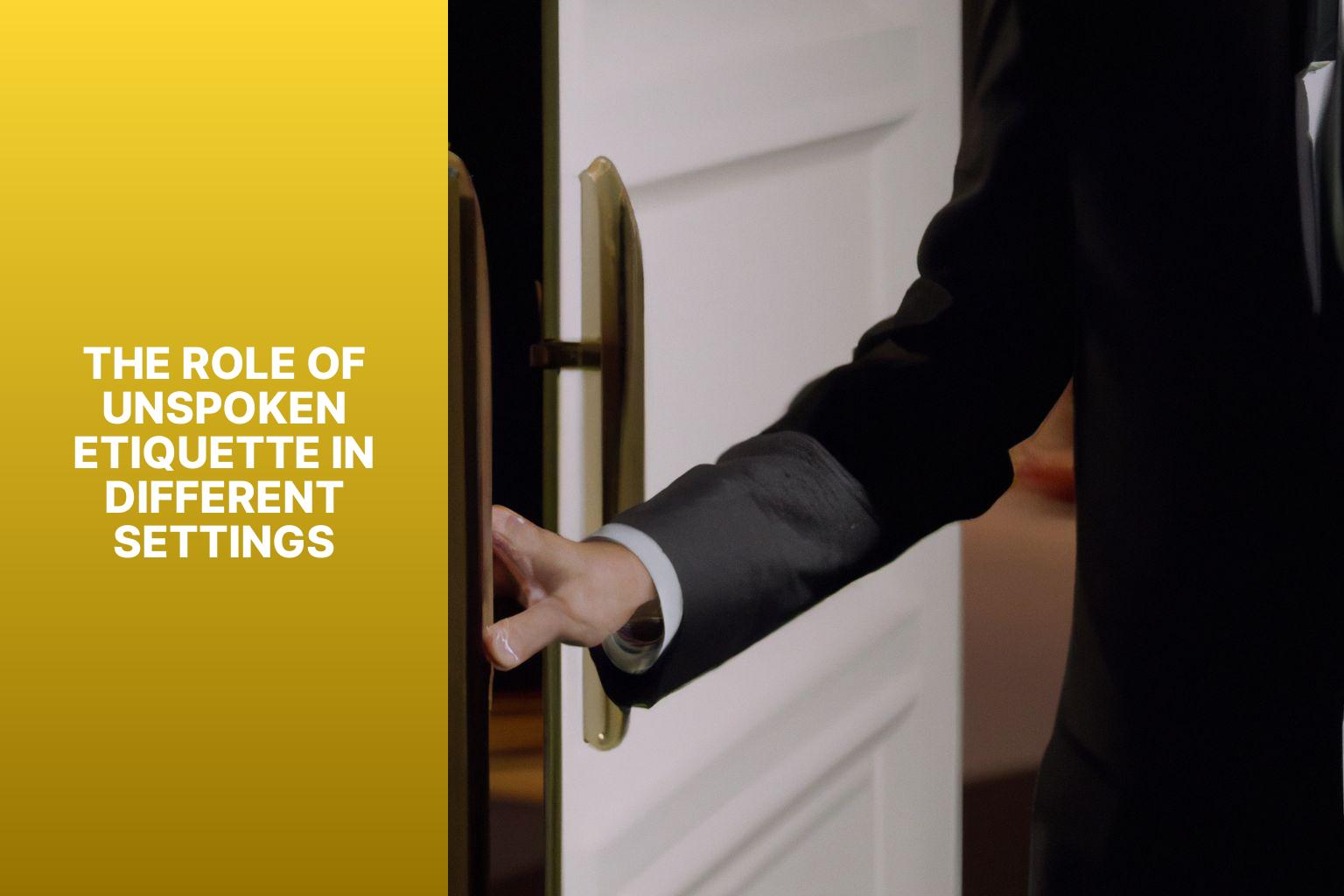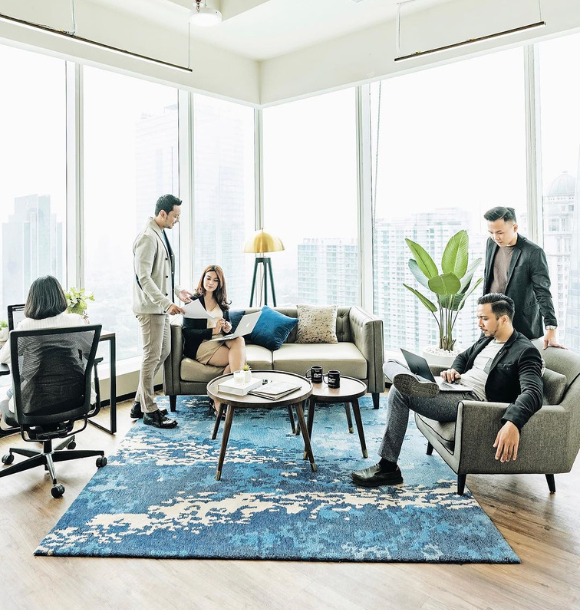The Silent Rules: Understanding Unspoken Etiquette
The Silent Rules: Understanding Unspoken Etiquette
Unspoken etiquette, often referred to as the silent rules of social interaction, plays a crucial role in our daily lives. While verbal communication is important, nonverbal cues and unspoken expectations shape our interactions and relationships.
Understanding and following unspoken etiquette is essential for maintaining harmonious and respectful connections in various settings. A study conducted by sociologist Deborah Tannen highlights the significance of unspoken rules and how they contribute to effective communication and social cohesion.
Silent rules encompass a wide range of behaviors, norms, and customs that are not explicitly stated but are understood and expected in different contexts. They dictate appropriate conduct and help establish social order. The role of unspoken etiquette varies depending on the setting. In social settings, it guides conversations, greetings, and personal space. In the workplace, unspoken rules govern professional conduct, collaboration, and communication. In public spaces, they influence behavior towards others and the environment. Cultural context further shapes unspoken etiquette, with different societies having unique expectations and norms.

Understanding common unspoken etiquette rules is essential for navigating social situations smoothly. Some examples include respecting personal space, maintaining appropriate body language, following conversational cues, practicing dining manners, and adhering to phone etiquette. Awareness of dress code expectations is vital for presenting oneself appropriately in various settings.
Failing to observe unspoken etiquette can have consequences, ranging from minor social awkwardness to damaging relationships or professional opportunities. Ignoring these silent rules may lead to misunderstandings, discomfort, and a negative perception of one’s behavior.
Learning unspoken etiquette can be achieved through various methods. Observing and learning from others is a valuable approach, as it allows for the assimilation of behaviors, gestures, and responses. Reading etiquette guides provides insights into societal norms and expectations. Seeking guidance and advice from mentors, elders, or professionals who are well-versed in unspoken etiquette can also be beneficial.
By understanding and practicing unspoken etiquette, we can navigate social interactions with grace, respect, and cultural sensitivity. It leads to better communication, positive relationships, and a more harmonious social environment.
Key Takeaways:
- The importance of unspoken etiquette: Unspoken etiquette plays a crucial role in maintaining harmonious social interactions and professional relationships.
- Understanding silent rules: Silent rules are the unwritten guidelines that govern behavior and communication in different settings, including social, workplace, public spaces, and cultural contexts.
- The impact of unspoken etiquette: Ignoring unspoken etiquette can lead to misunderstandings, conflicts, and a negative impact on personal and professional interactions.

Photo Credits: Www.Moderngentlemanmagazine.Com by Raymond Gonzalez
The Importance of Unspoken Etiquette
The importance of unspoken etiquette, also known as the importance of unspoken manners, is clearly evident in various aspects of our everyday interactions. It plays a crucial role in promoting respectful communication by encouraging the use of polite language, active listening, and appropriate eye contact.
Unspoken etiquette not only fosters social cohesion but also establishes norms and customs that create a comfortable and inclusive environment. This is particularly important in professional settings where adhering to unspoken etiquette enhances teamwork and collaboration.Furthermore, unspoken etiquette encompasses cultural sensitivity, which necessitates understanding and respecting different cultural customs. It also highlights the significance of paying attention to non-verbal cues such as body language and facial expressions. By recognizing and practicing unspoken etiquette, we contribute to a courteous and considerate society where individuals feel valued and respected.
This, in turn, promotes overall well-being and harmony within our communities. So, let’s all embrace the importance of unspoken etiquette for a better and more harmonious society.
What are Silent Rules?

Photo Credits: Www.Moderngentlemanmagazine.Com by Larry RobinsonSilent rules, also known as unspoken guidelines, are a set of rules that govern social interactions. Members of a society or group are expected to understand and follow these rules. They play a significant role in establishing expectations and ensuring appropriate behavior. Silent rules differ across cultures but are necessary for maintaining harmonious interactions.
Communication, personal space, and social etiquette are all areas that silent rules govern. For instance, waiting in a queue, respecting personal space, and greeting someone when entering a room are examples of silent rules. Adhering to these guidelines enables us to navigate social situations smoothly.
To have effective communication and successful social interactions, it is crucial to understand silent rules. By observing and following these guidelines, we can avoid misunderstandings and meet societal expectations.
It should be noted that silent rules may vary and evolve over time. Hence, being observant and adaptable to different social environments is essential. Keeping these rules in mind fosters positive interactions and relationships.
The Role of Unspoken Etiquette in Different Settings

Photo Credits: Www.Moderngentlemanmagazine.Com by Carl Jackson
Unspoken etiquette plays a crucial role in various settings, shaping the dynamics and interactions among individuals. In this section, we’ll explore the significance of unspoken etiquette across social settings, the workplace, public spaces, and within different cultural contexts. From unspoken gestures to subtle cues, we’ll uncover how these unwritten rules influence our behavior, relationships, and overall experiences in these diverse environments. Get ready to dive into the unspoken world of etiquette and unravel its impact in different settings.
Social Settings
In social settings, etiquette is crucial for smooth interactions and a harmonious environment. It is important to be aware of and follow social norms in order to avoid misunderstandings and make a positive impression.
Pay attention to one’s body language and respect personal space, as these are key considerations. By respecting others’ personal space, one demonstrates courtesy and consideration. Maintaining good eye contact during conversations shows engagement and respect.It is also important to be mindful of tone of voice and facial expressions, as they convey emotions and can impact the dynamics of the conversation.
When it comes to dining etiquette, it is important to know table manners. Make sure to use utensils correctly, chew with your mouth closed, and be considerate of others’ dietary restrictions or allergies. It is also polite to wait for everyone to be served before starting to eat.
By following these unspoken rules, one can cultivate positive relationships and create a comfortable atmosphere in social settings.
Proper social etiquette enhances communication, fosters respect, and promotes a sense of belonging. It is always important to practice good etiquette in any social setting for social harmony.
Personal Space and Body Language
Personal space and body language are two important aspects of unspoken etiquette. Respecting personal space is crucial for ensuring comfort and minimizing conflicts. It is essential to be aware of the appropriate distance to maintain in various situations.In social settings, it is customary to maintain a certain distance while engaging in conversations. Invading someone’s personal space by standing too close can make them feel uncomfortable. To show respect for personal boundaries, it is advisable to keep a comfortable distance of approximately 1 to 3 feet.
Furthermore, body language plays a significant role in communication. Non-verbal cues such as eye contact, facial expressions, and gestures can convey messages and influence how others perceive us. Maintaining appropriate eye contact demonstrates attentiveness and interest, whereas avoiding eye contact may be interpreted as disinterest or disrespect.
Being mindful of body language signals can help navigate social situations more smoothly. An open and relaxed body posture conveys approachability and friendliness, while crossed arms or tense body movements may indicate defensiveness or discomfort.Understanding and adhering to personal space and body language etiquette is crucial for establishing positive relationships and avoiding misunderstandings. By being aware of these unspoken signals, we can engage in social interactions with grace and align our actions with our intentions.
Conversation Etiquette
When it comes to conversation etiquette, there are guidelines that can help ensure smooth and respectful communication.
1. Actively listen: Practice conversation etiquette by actively listening to the speaker without thinking about your response. Maintain eye contact, nod, and provide verbal cues to show engagement.
2. Respect personal space: An important aspect of conversation etiquette is giving others enough personal space. Remember to maintain a proper distance and avoid invading their personal bubble.
3. Wait for your turn: Another key aspect of conversation etiquette is to wait for your turn to speak. Avoid interrupting others while they speak and patiently wait for them to finish before sharing your own thoughts.
4. Be mindful of body language: Your body language plays a significant role in conversation etiquette. It is important to maintain an open posture, avoid crossing your arms, and use facial expressions that show interest.
5. Speak clearly and concisely: Practice conversation etiquette by speaking clearly and concisely. Be mindful of your pace, volume, and tone to ensure easy understanding.
6. Avoid sensitive topics: It is advisable to steer clear of controversial or sensitive topics that can lead to arguments or discomfort. Focus on finding common ground or discussing neutral subjects.
7. Show respect and empathy: Conversation etiquette involves treating others with respect and empathy, even if you disagree with them. Be open to different perspectives and avoid making offensive remarks.
8. Use appropriate language: Pay attention to your vocabulary and language choices. Avoid using offensive or inappropriate language that could hurt someone.
9. Receive feedback gracefully: Conversation etiquette includes accepting feedback or criticism gracefully and being open to learning. Provide feedback constructively and respectfully.Remember, following these etiquette guidelines can lead to effective and respectful conversations.
Dining Etiquette

Dining EtiquetteWhen it comes to dining etiquette, following guidelines ensures a pleasant and respectful experience.
1. Table manners: Use proper table manners in formal or fine dining settings. Keep elbows off the table, use utensils correctly, and chew with your mouth closed.
2. Napkin use: Place your napkin on your lap when seated and use it to blot your mouth when necessary. At the end of the meal, place your napkin neatly on the table to the left of your plate.
3. Utensil placement: Pay attention to utensil placement. Use the outermost fork for the first course and work your way in with subsequent courses. Place utensils parallel to each other on your plate when finished eating.
4. Engage in polite conversation: Engage in polite and appropriate conversation. Avoid discussing controversial topics or using offensive language.
5. Consider dietary restrictions: Inform your host or server of dietary restrictions or allergies before the meal. Ensure suitable options are available for you.
6. Wait for everyone to be served: Show respect for the host by waiting for all guests to be served before starting your meal. This allows everyone to begin eating at the same time.
7. Thank the host: Express gratitude to the host for the invitation and the meal. A simple “thank you” is appreciated.Remember, following dining etiquette shows respect and consideration for others and enhances the dining experience.
Workplace
In the workplace, it is essential to adhere to unwritten workplace etiquette to foster professionalism and cultivate positive relationships with colleagues. Here are some fundamental aspects to consider regarding workplace etiquette:
1. Office Etiquette: It is crucial to maintain cleanliness and organization in shared spaces. It is advisable to refrain from using loud ringtones or speaking loudly on the phone to avoid disrupting others.
2. Dress Code: Ensuring a professional appearance by adhering to the established dress code is highly important. Dress appropriately, considering both the role and the company culture.
3. Professional Relationships: Building respectful and professional relationships with coworkers is key. It is essential to treat everyone with courtesy, avoiding engaging in gossip or displaying negative behavior.
4. Time Management: Demonstrating respect for others’ time involves punctuality for meetings and deadlines. Effectively prioritizing tasks and promptly communicating any delays or conflicts are also crucial.
5. Communication Etiquette: Clear and concise communication, whether written or verbal, is essential. Mindful choice of tone is important, remaining polite and professional at all times.
6. Business Etiquette: Familiarizing oneself with common business etiquette practices, such as addressing superiors by their preferred title and displaying proper table manners during business meals, is essential.
By adhering to these workplace etiquette guidelines, you can foster a harmonious and respectful work environment.
Showing respect for others’ time, space, and professional boundaries will contribute to cultivating a positive and productive workplace culture.
Office Etiquette
Office etiquette is an essential aspect of maintaining a positive work environment and professional relationships. Incorporating office etiquette contributes to a productive schedule, respects others’ time, and ensures a positive atmosphere. It is important to arrive on time for meetings and appointments, as this demonstrates respect for others’ time. Dressing appropriately and speaking respectfully are ways to maintain professionalism in the workplace. Engaging in gossip or office politics should be avoided.Effective communication plays a vital role in maintaining office etiquette. Actively listening, speaking clearly and concisely, and using professional written communication are crucial. Collaboration with coworkers, sharing ideas and responsibilities, and respecting others’ opinions are important aspects of office etiquette.
Maintaining a clean and organized workspace not only promotes productivity but also shows consideration for others who may use the same space. Following meeting protocols, being prepared, actively participating, and avoiding interruptions while others speak are important etiquette guidelines.
Respecting personal space and privacy is essential in an office environment. It is important not to touch others’ belongings and to be mindful of others’ need for concentration. Using technology responsibly and respectfully is another important aspect of office etiquette. Excessive personal use of company resources should be avoided, and it is essential to adhere to technology policies.
When conflicts arise, it is crucial to resolve them professionally through open communication and compromise. By following these office etiquette guidelines, employees can create a positive and respectful workplace atmosphere, foster better relationships, and improve overall productivity.
When navigating dress codes, it’s crucial to understand the expectations and guidelines for different settings. Here are some key considerations:
1. Identify the dress code: Before attending an event or entering a workplace, find out if there is a specific dress code. This information can usually be obtained through invitations, company policies, or by asking the organizer or supervisor.
2. Professional attire: In formal business settings, such as corporate offices or professional conferences, dress in business attire. This typically includes suits, tailored dresses, or dress shirts with pants or skirts. Ensure clothing is clean, well-fitted, and wrinkle-free.
3. Casual or business casual: In more relaxed work environments or social settings, there may be a casual or business casual dress code. This allows for flexibility and comfort while maintaining a professional appearance. It often includes khakis, chinos, collared shirts, blouses, or sundresses.
4. Appropriate footwear: Pay attention to the type of footwear allowed. Some environments may require closed-toe shoes, while others may permit sandals or sneakers. Avoid excessively casual or worn-out shoes in professional environments.
5. Avoid extremes: When unsure, be slightly more formal. Avoid clothing that is revealing, oversized, or excessively casual, as it may give a negative impression.
6. Personal style within limits: Express personal style while conforming to the dress code. Look for ways to incorporate personal touches, such as accessories or creative styling, while respecting the guidelines.
7. Be adaptable: Dress codes may vary depending on the occasion or cultural context. Adapt to the expectations of the environment while ensuring appropriateness and professionalism.By considering these factors, you can navigate dress codes with confidence and ensure that your attire aligns with the expectations of the setting.
Professional Relationships
When it comes to professional relationships, following etiquette rules is essential for a positive work environment. Professional relationships are built on effective communication, so it is important to actively listen, speak clearly, and respect others’ opinions. Collaboration is another key factor, which requires open-mindedness and compromise. It is important to contribute your ideas and be receptive to feedback.
Trust is the foundation of any professional relationship. Being honest, reliable, and maintaining confidentiality are crucial in building trust. Respect should also be shown for colleagues’ time, boundaries, and personal space. It is important to be mindful of cultural differences and treat everyone professionally.
Conflict resolution is another important aspect of professional relationships. It is important to address conflicts professionally by listening to all parties involved and finding a mutually beneficial solution. Networking is also crucial in building professional relationships. Attending industry events, engaging in professional conversations, and creating meaningful connections are key.
Mentoring can also contribute to career growth in professional relationships. Learning from experienced professionals and offering guidance to junior colleagues are valuable opportunities. It is important to remember that building strong professional relationships takes time and effort. By following these etiquette rules, you can foster productive relationships.
Public Spaces
In public spaces, such as public transportation, cleanliness and hygiene, and giving people space, it is important to consider unspoken etiquette. These guidelines help create a harmonious and respectful environment for everyone in public spaces.
When using public transportation, be considerate of others. Offer seats to those who need them, such as pregnant women, the elderly, or individuals with disabilities. Keep conversations low and avoid playing loud music to maintain a peaceful atmosphere in public transportation.In terms of cleanliness and hygiene, it is important to keep public spaces clean for everyone’s comfort. Dispose of trash properly and refrain from littering. If you find spills or messes, report them to the appropriate authorities or cleaning staff to ensure a clean environment for all.
Respecting personal boundaries is essential in public spaces. Avoid crowding or touching others without their consent. Be mindful of personal space when standing in lines or waiting in crowded areas.
By following these unspoken rules in public spaces, you contribute to a positive and respectful atmosphere. Respecting personal space, cleanliness, and being considerate in public transportation are all essential aspects of unspoken etiquette. Remember, small actions can greatly enhance the overall experience for everyone involved in public spaces.
Public Transportation
- Public Transportation is crucial for daily commuting. To ensure a smooth and comfortable experience, it’s important to follow etiquette rules.
- Respect personal space. Don’t crowd or stand too close to others on buses, trains, or subways.
- Offer your seat to those who need it more, such as pregnant women, elderly passengers, or individuals with disabilities.
- Keep noise levels low. Use headphones and minimize loud conversations or music that can disturb others.
- Be mindful of odors. Avoid using strong perfumes, colognes, or consuming food with strong smells in enclosed spaces.
- Don’t block pathways. Keep aisles and entrances clear of bags and belongings to allow easy movement.
- Observe boarding and exiting protocols. Wait for others to get off before entering or exiting a bus or train.
- Keep public transportation clean. Dispose of trash in designated bins to maintain cleanliness.
- By following these etiquette rules, we can create a more pleasant and respectful environment for everyone. Remember to prioritize the comfort and well-being of fellow passengers.
Cleanliness and Hygiene
Maintaining cleanliness and hygiene is crucial for unspoken etiquette. Personal cleanliness not only impacts your well-being but also affects others around you. Good personal hygiene practices are essential in social settings. Regular bathing or showering, brushing teeth, and wearing clean clothes are basic cleanliness habits that contribute to a pleasant environment. Regularly washing hands with soap and water helps prevent the spread of germs and infections. It is especially important before meals, after using the restroom, or when in contact with a sick person.
Managing body odor is part of maintaining proper personal hygiene. Using deodorants or antiperspirants can help control body odor and ensure personal comfort and consideration for others. Show respect for public spaces, such as public transportation, libraries, or restaurants, by keeping them clean. Avoid littering, clean up after yourself, and leave public spaces as you found them. Ensure personal belongings, like phones or bags, are clean and well-maintained. This improves personal hygiene and conveys respect and professionalism.Prioritizing cleanliness and hygiene contributes to a positive environment and creates a considerate and respectful atmosphere for everyone involved. Remember, being mindful of cleanliness and hygiene fosters healthy and harmonious interactions.
Giving People Space

Photo Credits @lets.gowork
Giving people space is an essential aspect of unspoken etiquette in various settings. Respecting personal boundaries and physical distance promotes comfortable interactions and prevents conflicts. Here are some key points to consider when giving people space:
1. Social Settings: Maintain an appropriate distance during personal conversations to ensure comfort. Avoid standing too close or invading personal space.
2. Workplace: Respect colleagues’ personal space by giving them enough room to work comfortably. Avoid unnecessary physical contact or invading their desk space.
3. Public Spaces: Be mindful of others in public transportation. Do not crowd or push when entering or exiting vehicles. Maintain personal hygiene to prevent the spread of germs.
4. Cultural Context: Different cultures have varying norms for personal space. Understand and respect these differences when interacting with people from diverse backgrounds.
By respecting personal boundaries, we can promote positive social interactions and create a comfortable environment. Remember, giving people the space they need demonstrates consideration and understanding in various social contexts.
Cultural Context
- Cultural context plays a vital role in shaping social interactions and preventing misunderstandings. Each culture has its own set of norms and expectations when it comes to behavior, which must be acknowledged and honored.
- The impact of cultural context on communication and interaction is significant. It encompasses various aspects such as gestures, greetings, personal space, and body language. For example, while maintaining eye contact during conversations is considered respectful in certain cultures, it may be viewed as rude in others.
- Tone of voice and facial expressions also vary across cultures. Some cultures value emotional expressiveness, while others prioritize a calm and composed demeanor.
- Moreover, handshakes and greetings differ culturally. A firm handshake is seen as a sign of confidence and respect in some cultures, while a softer handshake is more suitable in others.
- Understanding cultural context is essential for effective communication and fostering positive relationships, especially in multicultural workplaces or when traveling to foreign countries. Being aware of and adapting to the unspoken etiquette of different cultures demonstrates respect and a willingness to integrate into diverse environments.
- Learning about cultural context can be accomplished by observing and learning from others, reading culture-specific etiquette guides, and seeking guidance from local experts. It is important to approach cultural differences with an open mind and a desire to enhance cultural proficiency, as this leads to improved social interactions and prevents unintentional offenses.
Personal Interactions
Personal interactions are crucial in everyday life, and unspoken etiquette plays a vital role in ensuring respectful communication. Here are important points to consider:
1. Eye contact: Maintaining appropriate eye contact conveys interest and attentiveness in the conversation.
2. Tone of voice and facial expressions: Our tone of voice and facial expressions impact how our message is perceived. Be mindful of conveying thoughts and emotions accurately.
3. Handshakes and greetings: A firm handshake and polite greeting when meeting someone or reuniting demonstrate respect and create a positive impression.By adhering to these unspoken rules, individuals can cultivate strong relationships and create a comfortable communication environment.
Eye Contact
Eye contact is crucial for interpersonal communication as it conveys interest, trust, and respect. Maintaining eye contact in a conversation shows that you are fully present and attentive, fostering connection and understanding.In social settings, eye contact is vital for building relationships. It signals active engagement and interest in the other person, creating a comfortable and friendly environment for open communication.In professional settings, eye contact demonstrates confidence, credibility, and professionalism. It shows that you are interested and actively listening, thereby building trust and rapport in professional relationships.
It is important to respect cultural differences and individual preferences when it comes to eye contact. Prolonged eye contact may be seen as disrespectful or intrusive in some cultures, while it is expected and valued in others.
Tone of Voice and Facial Expressions
When communicating, tone of voice and facial expressions are crucial for conveying messages effectively. These nonverbal cues greatly impact how messages are received and interpreted.
Tone of voice refers to how someone speaks, including pitch, volume, and intonation. It conveys emotions like happiness, anger, or indifference. Using a warm and friendly tone creates a positive and welcoming atmosphere. Conversely, a harsh or aggressive tone leads to misunderstandings and conflict.
Facial expressions are also important in nonverbal communication. They reveal emotions and attitudes, such as happiness, surprise, or sadness. A genuine smile builds rapport and trust, while a frown or raised eyebrows may indicate disagreement or confusion.
Being aware of both your own tone of voice and facial expressions, as well as those of others, is essential for effective communication. Paying attention to these nonverbal cues helps you understand the underlying meaning of a message and respond appropriately.In professional settings, maintaining a respectful and professional tone of voice and facial expression is crucial for conveying professionalism and competence. This establishes credibility and builds positive relationships with colleagues and clients.Understanding the importance of tone of voice and facial expressions enhances your communication skills and improves interactions with others.
Handshakes and Greetings

When it comes to handshakes and greetings, there are certain etiquette rules to keep in mind for personal and professional interactions:
1. Be confident and firm: When shaking someone’s hand, have a confident and firm grip to show respect and professionalism
.2. Maintain eye contact: Making eye contact during a handshake demonstrates attentiveness and sincerity, showing respect and engagement in the conversation.
3. Smile and greet: Along with the handshake, it is important to smile and greet the person warmly to create a positive and friendly impression.
4. Use a suitable greeting: Choose an appropriate greeting based on the setting and relationship with the person. In professional settings, common greetings include “Hello” or “Nice to meet you,” while in more informal situations, you can use “How are you?” or “Good to see you.”
5. Pay attention to cultural norms: Be aware of and respect the cultural norms of the person you are interacting with, as handshakes may vary in firmness and greetings may involve additional gestures such as bowing.
6. Respect personal boundaries: Some individuals may prefer not to engage in physical contact, so always be attentive to cues and respect personal boundaries.Following these etiquette rules can set a positive tone for interactions and help establish rapport and mutual respect.
Communication Etiquette
Communication etiquette is crucial in personal and professional interactions. It helps establish effective and respectful communication. To ensure proper communication etiquette, follow these guidelines:
1. Actively listen: When conversing, actively listen and show genuine interest. Make eye contact, nod, and ask clarifying questions.
2. Use clear and concise communication: Express thoughts and ideas clearly and concisely. Avoid using jargon or technical terms that may not be understood.
3. Respectful language: Use polite and respectful language. Avoid offensive or derogatory remarks.
4. Respond in a timely manner: Reply to messages, emails, or phone calls promptly. Show respect for others’ time and demonstrate professionalism.
5. Maintain a professional tone: Use a professional tone in all forms of communication. Avoid slang or inappropriate language
.6. Pay attention to non-verbal cues: Observe body language and facial expressions to better understand emotions and intentions.
7. Respect privacy and confidentiality: Do not share personal or sensitive information without permission.
8. Practice etiquette in digital communication: Be mindful of your interactions on social media and other digital platforms. Be respectful, avoid conflicts, and use proper grammar and spelling.By following these communication etiquette guidelines, you can enhance personal and professional relationships and ensure effective communication in various settings.
Phone Etiquette
When it comes to phone etiquette, it is crucial to follow these guidelines for effective communication and professionalism. Make sure to answer calls promptly to show respect for the caller’s time.It is important to maintain a polite and professional tone throughout the conversation. Avoid speaking too loudly or softly, as it can hinder clear communication. It is essential to identify yourself and state the purpose of the call. This helps establish clarity and context for the conversation.
Active listening is another key aspect of phone etiquette. Give the caller your full attention and avoid interrupting. This shows respect and understanding towards the person on the other end of the line. Speaking clearly and concisely is also vital. Use clear language and speak at a moderate pace to ensure the caller can understand you properly.To avoid distractions, try to find a quiet location where there is minimal background noise. This will ensure clear communication between you and the caller. Ending calls politely is equally important. Thank the caller and say goodbye in a friendly and professional manner.If you happen to miss a call, it is essential to return it as soon as possible. This displays good communication habits and maintains a positive impression. It is crucial to respect personal and professional boundaries when using your phone. Avoid using it in inappropriate situations or during meetings. Always prioritize privacy and confidentiality.
By following these phone etiquette guidelines, you can significantly improve your communication skills and maintain professionalism in all interactions. Remember, phone etiquette is not only important in professional settings but also in personal relationships and everyday interactions.
Social Media Etiquette
When it comes to social media etiquette, follow these guidelines for positive and respectful interactions:
- Think before you post: Consider the impact of your words and images on others.
- Respect privacy: Avoid sharing personal or sensitive information about others without their consent.
- Be kind and respectful: Treat others on social media with kindness and respect.
- Avoid oversharing: Share aspects of your life while maintaining privacy.
- Engage in meaningful conversations: Use social media for constructive discussions and positive interactions.
- Verify information before sharing: Verify the accuracy of information before sharing it on social media.
- Respect intellectual property: Give proper credit to original creators when sharing content.
- Know the platform’s rules: Familiarize yourself with each social media platform’s rules and guidelines.
- Be mindful of timing: Consider the timing of your posts, especially when sharing sensitive content.
- Monitor your online presence: Regularly review and remove any inappropriate or disrespectful content from your social media accounts.
By following these social media etiquette guidelines, you can create a positive and respectful online presence while fostering meaningful connections with others.
Professional Etiquette
Professional etiquette plays a vital role in both personal and professional interactions, and it has a significant impact on career success and professional relationships. There are several key aspects to consider when it comes to professional etiquette.
First and foremost is business etiquette, which involves being punctual for meetings, respecting others’ time, and following communication protocols. Adhering to these guidelines ensures that you maintain proper business etiquette.Another important aspect of professional etiquette is adhering to the dress code. By dressing appropriately for the workplace, you show professionalism and respect for the culture of the organization. This helps create a positive first impression and fosters a professional environment.
Effective time management is crucial for productivity and professionalism. It is essential to prioritize tasks, meet deadlines, and respect others’ time by being prompt and organized.In terms of communication etiquette, it is important to practice clear, concise, and respectful professional communication. This includes using active listening skills, using appropriate language, and avoiding distractions.
Building professional relationships is also a key aspect of professional etiquette. By cultivating positive relationships with colleagues, you can create a collaborative and supportive work environment. This involves networking, appreciating colleagues’ contributions, and being a team player.By adhering to these professional etiquette guidelines, you can create a strong impression, build trust, and enhance your professional reputation. It is important to continually cultivate and refine your professional etiquette skills to succeed in today’s competitive work environment.
Business Etiquette
Business etiquette is crucial in professional interactions. It sets the tone for how individuals and organizations conduct themselves. Adhering to appropriate business etiquette contributes to positive relationships, effective communication, and overall business success.Key aspects to consider for business etiquette include:
- Professional appearance: Dress appropriately for the occasion, following the dress code. Maintaining a well-groomed appearance shows professionalism and respect.
- Punctuality: Being on time shows respect for others’ time and reliability. Arriving early allows for preparation and avoids causing delays.
- Effective communication: Use clear and concise communication skills. Actively listen and express ideas professionally without interrupting others.
- Email and phone etiquette: Be mindful of your tone, ensuring clear and professional messages. Respond promptly and avoid using jargon or slang.
- Meeting etiquette: Prepare by reviewing the agenda and relevant materials beforehand. Arrive on time and actively participate, respecting others’ contributions.
- Respect for cultural differences: Be aware of and respect cultural differences when conducting business with individuals from different backgrounds. Avoid assumptions and adapt to cultural norms.
- Networking: Approach networking events with a positive attitude. Engage in meaningful conversations, exchange business cards, and follow up with contacts afterwards.
By following these guidelines, individuals create a positive impression, build professional relationships, and enhance their overall business proficiency.Dress CodeFollow dress code guidelines for different settings. Consider the following:
- Know the expectations: Familiarize yourself with the dress code guidelines of specific events, workplaces, or social settings. Understand if the dress code is formal, business casual, or casual.
- Appropriate attire: Dress appropriately for the occasion. Choose clean, well-fitted, and good condition clothing. Avoid anything too revealing, provocative, or casual.
- Respect cultural norms: Dress according to cultural traditions and customs, especially for specific events or when interacting with people from different backgrounds. Research appropriate attire to avoid offense or discomfort.
- Accessorize thoughtfully: Pay attention to accessories like jewelry, shoes, and bags. Make sure they complement your outfit and suit the setting. Avoid excessive or distracting accessories.
- Maintain personal hygiene: Dressing appropriately includes cleanliness, good grooming, and avoiding odor.
- Express personal style within boundaries: Adhere to the dress code while still reflecting your personality. Choose clothing that meets the expectations of the setting.
- Observe others: When unsure of the dress code, observe what others are wearing in similar settings. Take cues from their attire to ensure appropriate dressing.
- Seek clarification if unsure: If uncertain about the dress code, ask the host, organizer, or supervisor for guidance to ensure appropriate dressing.
Time Management
When it comes to time management, it is crucial to prioritize tasks, set goals, and make efficient use of the available time. Identifying priorities is the first step in effectively allocating time and avoiding delays. By determining important tasks with specific deadlines, individuals can ensure that they allocate enough time for each task and complete them in a timely manner.
- Setting realistic goals is another important aspect of time management. Breaking tasks into manageable goals, each with its own deadline, creates a sense of accountability and ensures timely completion. This approach helps individuals stay focused and motivated.
- Using a planner or calendar is a helpful tool in creating a schedule and visualizing time commitments. By having a clear overview of their schedule, individuals can better manage their time and stay on track. It allows them to allocate the necessary time for each task and helps in avoiding conflicts or overlapping commitments.
- Distractions can significantly hinder productivity. Minimizing phone use and reducing social media consumption during work or study sessions can greatly improve focus and efficiency. By eliminating these distractions, individuals can devote their full attention to tasks at hand.
- Sometimes, it is necessary to delegate or outsource tasks in order to lighten one’s workload. Assigning tasks to colleagues or professionals who specialize in those areas can free up valuable time for other important responsibilities.
- Taking regular breaks is vital for maintaining productivity and preventing burnout. Prioritizing breaks allows individuals to refresh their minds and come back to tasks with renewed energy. By incorporating short breaks into their schedule, individuals can boost their overall productivity and well-being.
- It is important to regularly review and adjust the schedule for maximum efficiency. By evaluating the effectiveness of the current schedule and making necessary adjustments, individuals can optimize their time management strategies and enhance productivity.
- Implementing these strategies can greatly enhance productivity, both in personal and professional settings. By effectively managing time, individuals can accomplish more tasks, meet deadlines, and experience less stress.
Social Etiquette Gestures
Social etiquette gestures, such as holding the door open, offering seats, and expressing gratitude through thank you notes, are crucial for positive social interactions and creating a harmonious environment. Incorporating these social etiquette gestures into our daily lives demonstrates consideration, kindness, and appreciation for others. By practicing these gestures, individuals can cultivate a sense of community and contribute to a pleasant social experience for everyone.
Holding the Door Open
Holding the Door OpenWhen it comes to unspoken etiquette, holding the door open shows consideration and respect for others. Here are some key points to keep in mind:
- Be aware of your surroundings: Pay attention to people coming behind you and assess the situation. If someone is approaching the door with their hands full or struggling, it’s appropriate to hold the door open.
- Timing is important: Hold the door open long enough for the person behind you to comfortably pass through, but don’t hold it open for an excessive amount of time that may inconvenience others.
- Approach with confidence: When holding the door open, stand to the side and hold it with an open palm or a light touch. Avoid blocking the doorway or crowding the person trying to enter.
- Don’t expect gratitude: The purpose of holding the door open is to show kindness without expecting anything in return. Maintain a positive and gracious attitude, even if the person doesn’t acknowledge or thank you.
- Consider cultural norms: In some cultures, holding the door open may not be common. Respect cultural differences and adjust your actions accordingly.
By following these guidelines, holding the door open becomes a gesture that promotes good manners and creates a more courteous and inclusive environment.
Offering Seats or Letting Others Go First
When it comes to etiquette, offering seats or letting others go first demonstrates courtesy and respect. Here are some important considerations:
- Public transportation: On buses, trains, or other public transportation, offer your seat to those who may need it more, such as the elderly, pregnant women, or people with disabilities. This gesture improves their comfort and convenience.
- Crowded spaces: In waiting rooms or lobbies, if you see someone struggling with heavy bags or an elderly person standing, kindly offer them your seat. It shows compassion and consideration for their needs.
- Elevators and escalators: Allow others to enter or step on first before you when using an elevator or escalator. This practice maintains a smooth flow and prevents congestion.
- Queues or lines: When waiting in line, consider others who may be in a rush or have fewer items to purchase. Offer to let them go ahead of you, demonstrating thoughtfulness and a willingness to accommodate their needs.
- Social events: At events or gatherings, let others go first when entering a room, serving food, or starting a conversation. This behavior shows respect and acknowledges the importance of valuing others.
Remember, offering seats or letting others go first promotes kindness and consideration in various settings. By practicing these unspoken rules of etiquette, you contribute to a more harmonious and inclusive environment.
Thank You Notes and Expressions of Gratitude
When expressing gratitude, it is important to incorporate thank you notes and expressions of gratitude. These thank you notes and expressions of gratitude hold significance in acknowledging and showing appreciation for someone’s kindness, help, or support. Consider the following key points:
– Timeliness: It is crucial to promptly send thank you notes or express gratitude to demonstrate that you value and appreciate someone’s efforts.
– Personalized touch: Take the time to personalize your thank you note or expression of gratitude by mentioning specific details about how the person’s actions made a difference in your life or situation.
– Sincerity: It is essential to genuinely and sincerely express your gratitude, letting the person know how their actions positively impacted you and how thankful you are for their help or support.
– Specificity: Rather than a generic thank you, it is important to mention specific ways the person’s actions have benefited you to show that you paid attention and their assistance was meaningful.
– Handwritten notes: Handwritten thank you notes have a personal touch and are often seen as more sincere, showing that you took the time and effort to express your gratitude thoughtfully.
– Verbal expressions of gratitude: Don’t underestimate the power of verbally expressing gratitude in person, over the phone, or through video calls. It can effectively convey your appreciation.
– Reciprocity: Expressing gratitude can create a positive cycle of kindness. When someone receives thanks, they are more likely to feel appreciated and motivated to continue helping others.
Remember, expressing gratitude not only benefits the recipient but also enhances your overall well-being and strengthens relationships. Make it a habit to show appreciation and spread gratitude wherever you can.
Consequences of Ignoring Unspoken Etiquette
Ignoring unspoken etiquette can have significant consequences. It is important to be aware of these consequences to ensure smooth interactions and maintain positive relationships with others. Here are some consequences of ignoring unspoken etiquette:
- Offending Others: Ignoring unspoken etiquette can unintentionally offend others. For example, not greeting someone properly or failing to follow appropriate social cues can make others feel disrespected or ignored.
- Social Isolation: Neglecting unspoken etiquette norms can result in social isolation. Disregarding social norms such as interrupting others while they speak or invading personal space can make others perceive you as rude or disrespectful. This can lead to hesitancy in engaging with you and feelings of isolation.
- Damaged Professional Relationships: Ignoring unspoken etiquette in a professional setting can have negative consequences. Failing to promptly respond to emails, not showing respect to colleagues, or disregarding workplace protocols can damage professional relationships, limit career advancement opportunities, and hinder collaborative efforts.
- Missed Opportunities: Ignoring unspoken etiquette can cause you to miss important opportunities. For example, not following proper networking etiquette, such as maintaining eye contact or listening actively, can make a negative impression and potentially impact your ability to build connections or secure job offers.
- Reputation Damage: Consistently ignoring unspoken etiquette can damage your reputation. People may perceive you as disrespectful or unprofessional, which can affect your personal and professional relationships in the long run.
To avoid these consequences, it is crucial to be mindful of unspoken etiquette norms and adapt your behavior accordingly in social and professional settings.
How to Learn Unspoken Etiquette

Photo Credits: Www.Moderngentlemanmagazine.Com by Tyler Hall
Want to unravel the mysteries of unspoken etiquette? In this section, we’re diving deep into the art of learning unspoken etiquette. From observing and learning from those around you to brushing up on etiquette guides, and seeking guidance from experts, we’ll explore the various ways you can gain a deeper understanding of the silent rules that govern social interactions. Say goodbye to those awkward moments and embrace the confidence that comes with mastering unspoken etiquette.
Observing and Learning from Others
When it comes to learning unspoken etiquette, one highly effective strategy is to observe and learn from others. By carefully watching how people interact, you can obtain valuable insights and knowledge regarding the expected norms and behaviors in different situations.To start with, pay attention to body language. Take note of subtle cues such as eye contact, facial expressions, and posture, as they can provide important clues about appropriate behavior.Listening to conversations can be incredibly helpful. By doing so, you can learn the appropriate tone of voice, level of formality, and common phrases used in various settings. This will enable you to adapt and adjust your own communication style accordingly.
Another key aspect to consider is greetings and introductions. Take the time to observe how people greet and introduce themselves in different situations, whether it’s a simple handshake, a bow, or any other form of greeting. This will give you valuable insights into the proper way to initiate interactions.Nevertheless, it is essential to remember to always be respectful and discreet when observing others. Avoid intruding on personal space or making others feel uncomfortable. By observing and learning from others, you can gain valuable insights into unspoken etiquette, enhancing both your social and professional interactions.
Reading Etiquette Guides
Reading etiquette guides can be extremely valuable for individuals who want to learn about unspoken etiquette. These guides offer a wealth of comprehensive information on various aspects of social interactions, communication, and professional conduct. They provide specific guidance on how to navigate different situations and cultural contexts, helping individuals understand appropriate behavior and social expectations.
One of the key benefits of reading etiquette guides is that they are written by experts who have extensive knowledge and experience in etiquette. This means that the information provided is reliable and trustworthy. Etiquette guides are regularly updated to reflect the changing societal norms and customs, ensuring that readers have the most up-to-date information at their disposal.
By reading etiquette guides, individuals can also improve their social skills. These guides offer practical tips on effective communication, proper manners, and respectful behavior. By following the advice in these guides, individuals can enhance their social interactions and make a positive impression on others.
Etiquette guides emphasize self-awareness and self-improvement. They encourage readers to reflect on their own behaviors and make positive changes. This can lead to personal growth and development, making individuals more confident in social and professional settings.
Ultimately, reading etiquette guides equips individuals with the knowledge and skills necessary to navigate social settings, communicate effectively, and conduct themselves with respect and consideration. Whether attending a formal event or having a casual conversation, these guides can help individuals make a positive impression and maintain good relationships with others.
Seeking Guidance and Advice
When navigating social norms and expectations, seeking guidance and advice can be highly beneficial. It allows individuals to learn from the experiences of others who are well-versed in etiquette. By actively seeking guidance and advice, individuals can navigate complex situations and avoid unintentionally offending others.
One way to seek guidance and advice is by observing and learning from others. When interacting with people who display exemplary etiquette, individuals can observe their actions, body language, and communication styles to understand what is appropriate in different contexts. This approach allows for the cultivation of proficiency in etiquette.
Another method is reading etiquette guides. These resources provide comprehensive information on various aspects of etiquette, including personal interactions, communication etiquette, and professional conduct.
ETIQUETTE 101: A Guide to Social Decorum is an excellent resource that covers a wide range of topics and offers practical advice for navigating different social scenarios.Individuals can directly seek guidance and advice from mentors, elders, or etiquette professionals. These individuals possess extensive knowledge and experience in etiquettes and can provide personalized guidance tailored to specific situations. By actively seeking guidance, individuals can enhance their understanding of unspoken rules and improve their social interactions.
The Impact of Unspoken Etiquette in Personal and Professional Interaction

Photo Credits: Www.Moderngentlemanmagazine.Com by Arthur Nguyen
Unspoken etiquette plays a crucial role in both personal and professional interactions, exerting a significant impact on relationships and success. In personal interactions, unspoken etiquette sets the stage for social dynamics, influencing how individuals are perceived and establishing the degree of respect and rapport between them. By employing appropriate greetings, maintaining eye contact, and demonstrating active listening skills, individuals can strengthen their connections with others. Understanding cultural norms and adapting one’s behavior nurtures understanding and helps prevent any unintended offense.
In professional interactions, unspoken etiquette is indispensable for establishing credibility and professionalism. By dressing appropriately, using respectful language, and displaying punctuality, individuals can enhance their reputation and foster positive work relationships. Mastering non-verbal communication, including body language and facial expressions, is paramount in effectively conveying confidence and competence.
It is important to note that unspoken etiquette extends beyond immediate interactions, as it also influences future opportunities and advancement. Adhering to professional etiquette can build trust and open doors for career growth, while neglecting it may result in negative perceptions and limited progress.
Consequently, understanding and practicing unspoken etiquette is essential for successful interactions. By being mindful of their behavior and actions, individuals can create positive impressions, foster productive relationships, and ultimately achieve their goals.
Frequently Asked Questions
What are the unspoken rules of office etiquette?
The unspoken rules of office etiquette include valuing time, avoiding gossip, knowing your workplace, picking up after yourself, respecting others’ preferences, being professional, introducing others, switching off your phone during meetings, keeping your voice down while on the phone, and dressing appropriately.
Why is it important to be punctual and inform others if you’re running late?
Being punctual shows commitment and respect for others’ time. Informing others if you’re running late is considered polite and helps maintain mutual trust and cordial relationships in the workplace.
How does gossiping about colleagues affect your professional image?
Gossiping about colleagues reflects poorly on your character and may damage trust. It is important to maintain professionalism and focus on positive and constructive communication in the workplace.
Why is it crucial to understand the values and procedures of your workplace?
Understanding the values and procedures of your workplace is important for effective collaboration, respect for others’ work styles, and maintaining a professional image. It helps facilitate better communication and a harmonious work environment.
How can body language contribute to building professional relationships?
Body language, including a firm handshake, direct eye contact, and confident posture, conveys professionalism and reliability. On the other hand, crossed arms, lack of eye contact, or fidgeting may create negative impressions, such as disinterest or insincerity.
Why is it important to respect personal space in business interactions?
Respecting personal space is a significant aspect of business etiquette. Understanding and considering others’ boundaries is essential to avoid making others uncomfortable and to build stronger professional relationships.

